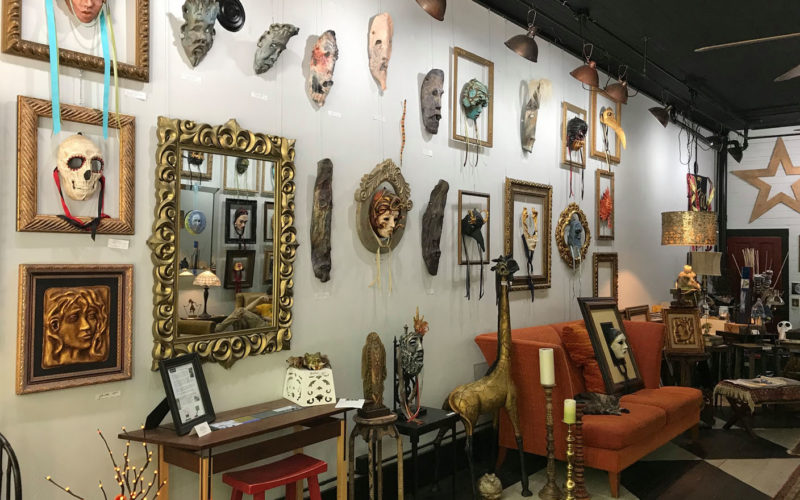Italian masks join unique art at White Street Walk
BECCA MARTIN-BROWN
bmartin@nwadg.com
Step through the door of Viso Art Studio in Eureka Springs, and you’ll feel like you’re in Europe. Even though the ceilings are high, the atmosphere is intimate and relaxed. The floors are wood painted in the classic diamond pattern of black-and-white marble. The walls are plaster over stone and clearly from a different time.
But it’s what’s hanging there — framed and unframed — that’s extraordinary. Look to one side and there’s a green man, a skull and the hooked nose of an Italian “plague doctor.” On the other? Images of Frida Kahlo, Vincent Van Gogh and Medusa, complete with snakes.
Kath Cantele and her son, Noah Cantele, might just make the most unusual art in Eureka Springs. They’ll be showing their work this year at the White Street Walk on May 17, but to get the full impact of their creativity, one has to stop by the studio and gallery on North Main Street. It’s the former Harp’s Old Time Grocery, and the building dates back to the turn of the 20th century, which is part of its charm. Kath Cantele says visitors are often “gobsmacked.”
“There’s something about our studio space that’s cathartic,” she muses. “People sit down, and they start talking. They seem to have something they need to get off their chest. We have people that spend an hour in the studio — and when they leave, they’re smiling.”
Cantele says the masks she and Noah create make her smile, too. It was not a calling she expected to find after 50, but when her Italian-born husband, Ron, died at the end of 2013, she sold everything — including their organic farm south of Berryville — and went to see the world. She ended up in Italy, where she has dual citizenship, studying maskmaking in Florence. “Something about the whole process captured me,” she says. And when Noah saw what she was doing, “it captured him, too.” In 2016, they returned to Eureka Springs, found the old store for sale, and “we have poured our hearts and souls into this building and our studio,” she says.
“It is a terribly interesting process,” Cantele says of making the papier mache masks in the Italian tradition. “It’s the same process used for hundreds of years, back to the time when masks were used for theatrical performances or during carnival, which you still see to this day.”

Cantele starts by sculpting a face from clay, “then you pour a plaster cast, dig the clay out and lay paper we import from Italy into the cast and build it up.” There’s been a learning curve, she admits, because the supplies she can get in the United States are not what she used in Florence. For example, white glue here is both too strong and too elastic. And she’s given up trying to source the carta lana paper anywhere but Europe.
Once the mask is created, the artists add acrylic paints — and often, that’s just the beginning. The masks may be aged in appearance. They may have their surfaces crackled. Or, as for the Medusa, Cantele may add a support structure to make the mask more three-dimensional — which pretty much leaves Italian tradition in the dust. But she’s all right with that.
“Sometimes the mask has other ideas,” she says with a laugh. “If I just let go and go with it, don’t put my pre-imaginings on it and just let it flow, it turns out. Some of most beautiful ones are the ones that veered away from traditional and incorporated unique, different things” like pieces of pine cone to create scales.
The masks range in price from around $180 to around $500 — “so my clients are predominantly from out of the area — Chicago, Dallas — not our typical Eureka Springs-on-the-weekend-from-Oklahoma customer,” Cantele says.
“My husband’s friends advised me against this whole thing, but my attitude was, ‘I’ve been safe, raised a family, worked hard. It was time for me to jump off this cliff — and see if I grew wings.”
__
FAQ
White Street Walk:
Kath & Noah Cantele
WHEN — 4-10 p.m. May 17
WHERE — Mary Springer’s front porch on White Street
COST — Free
INFO — Email zeek.taylor@cox.net
__
FYI
White Street
Traditions
“There will be approximately 45 artists showing during the walk,” says Zeek Taylor, one of the founding artists. “A part of the tradition of the event is seeing the return of exhibitors who have participated for many years.
“Once an artist experiences showing during the walk, they do not want to relinquish their spot in the one-night festival. Visitors and art collectors seek out their favorite artists knowing they will be here, and often it’s the one time of year when the artists and collectors meet and visit with each other.”



